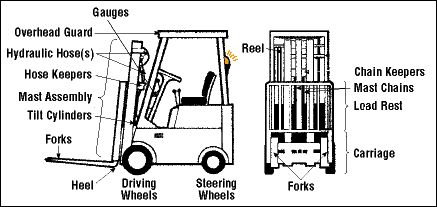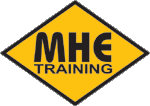When should an operator inspect the forklift truck?
An operator should inspect the forklift truck every day before using, or when returning from break as the vehicle.
What does a daily inspection involve?
The operator should carry out a visual check (“circle” check) before starting the forklift. After completing the visual pre-start check, the operator should do an operational pre-use check.
What should an operator inspect during the visual pre-use check?

- General condition and cleanliness.
- Floor — clear of objects that could cause an accident.
- Overhead — no obstructions.
- Nearby objects to avoid as you drive away.
- Engine oil level, fuel level, radiator water level (LPG, gas and diesel forklifts).
- Battery — fully charged; check cables for exposed wires; battery plug connections not loose, worn or dirty; vent caps not clogged; electrolyte levels in cells; hold downs or brackets keep battery securely in place.
- Bolts, nuts, guards, chains, or hydraulic hose reels not damaged, missing or loose.
- Wheels and tires — check for wear, damage, and air pressure, if pneumatic tires.
- Forks — forks not bent; no cracks present; positioning latches in good working condition; carriage castling not broken, chipped or worn.
- Chain anchor pins — not worn, loose or bent.
- Fluid Leaks — no damp spots or drips.
- Hoses — held securely; not loose, crimped, worn or rubbing.
- Horn — working and loud enough to be heard in working environment; other warning devices operational.
- Lights — head lights and warning lights operational.
- Report any problems identified in daily check to the supervisor immediately
No Responsibility is accepted for the accuracy of this article

